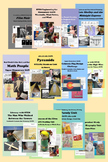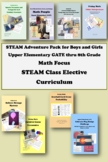MATH PEOPLE - UPPER ELEMENTARY GATE 20+ Hours! Gritty STEAM Real World Fun!
Portable Gifted and Talented
3.1k Followers
Resource Type
Standards
CCSS4.MD.A.2
CCSS5.MD.A.1
CCSS5.NBT.B.7
CCSS5.NF.A.1
CCSS5.NF.A.2
Formats Included
- Word Document File
Pages
59 pages
Portable Gifted and Talented
3.1k Followers
What educators are saying
Thank you! This is a great resource for my students in enrichment. It it just the right amount of challenge and intrigue causing the students to be engaged in the process.
Also included in
- All of it fresh and new and tried and kid-tested during the past school year—you are ready to rock and roll for 2016-17!Here you have over 350 pages and 75 hours of material—all with best practices in gifted and talented education.One stop. Huge discount over individual purchases: you save 47%. SPrice $29.99Original Price $54.91Save $24.92
- Pretty much everything in the Portable Gifted and Talented store is rated 4.0, but take a couple minutes to peruse the comments for these individual units. I think you’ll like what you see.Designed for two purposes:A curriculum for Middle School STEAM classes with MATH focus. Or . . .Upper ElementPrice $18.99Original Price $35.94Save $16.95
- Hours and hours and hours! Ready to go today!One of the best purchases I made in my early career was a book of guidelines for teaching gifted students. It contained a few samples of what sort of work these students might do. I’ve often lent it to colleagues over the years. What I really needed, tPrice $39.99Original Price $79.37Save $39.38
Description
Independent, small group, or whole class: you’ll find this unit to be of the same nature as my other strongly reviewed math units for 4th and 5th GATE and 6th (or even 7th) grades.
Download now if you are looking for real world/applied math challenges, grit, hands-on tasks, creative problem-solving, design, economics, and plenty of room for creativity!
This unit spans 20 or more hours of focused work time for an advanced learner (probably 30 hours if you teach this whole class). It’s ready-to-print and requires only a few materials commonly found in classroom.
You’ll get ready-to-print activity sheets, Common Core standards references, notes for teachers, self-guided independent study notes for students, and samples of students’ work.
As always my units are an active part of my GATE curriculum and kid-tested. This is not theory . . . it works!
Making Math People: We use the general proportions present in all humans to make a math person from card stock and brads. Students complete calculations using fractions, proportions, and percentages while they “build” their “people.”
Pee Wee Football: A real world word problem to express mathematical understanding of human body proportions.
Scaling to Actual Height: Make calculations and draw a picture based on written instructions. Think, solve, and prove your understanding!
Math People to Scale: Create a graphically designed challenge for friends, inviting them to convert your drawing to scale. Are we giants, tiny little guys, or gods in the making?
Easter Egg Hunt: Very challenging and very rewarding to the persistent, we use a 100 year old primary source photo from the Library of Congress to apply our knowledge of scale and proportion in a real life math activity.
Virtual Journey Mini Project: In this cross-curricular portion of the unit, students will launch their math people off on a virtual journey to a destination of the students’ choosing. In multi-step word problems, students will calculate stride length for their math people and the number of strides to various destinations both near and far. Students will practice research skills and summary writing as they gather and share information. Graphic design skills come into play as students pull all their research together for a poster which will be evaluated based on a rubric.
Clothing Design, Pricing, and Profits: In this final project, students will design four articles of clothing for their math people, advertise the clothing, take orders, calculate gross and net sales/profits, and go on a little shopping spree to spend their new found wealth. They’ll need to be creative with geometrical problem-solving to pull this off.
Download now if you are looking for real world/applied math challenges, grit, hands-on tasks, creative problem-solving, design, economics, and plenty of room for creativity!
This unit spans 20 or more hours of focused work time for an advanced learner (probably 30 hours if you teach this whole class). It’s ready-to-print and requires only a few materials commonly found in classroom.
You’ll get ready-to-print activity sheets, Common Core standards references, notes for teachers, self-guided independent study notes for students, and samples of students’ work.
As always my units are an active part of my GATE curriculum and kid-tested. This is not theory . . . it works!
Making Math People: We use the general proportions present in all humans to make a math person from card stock and brads. Students complete calculations using fractions, proportions, and percentages while they “build” their “people.”
Pee Wee Football: A real world word problem to express mathematical understanding of human body proportions.
Scaling to Actual Height: Make calculations and draw a picture based on written instructions. Think, solve, and prove your understanding!
Math People to Scale: Create a graphically designed challenge for friends, inviting them to convert your drawing to scale. Are we giants, tiny little guys, or gods in the making?
Easter Egg Hunt: Very challenging and very rewarding to the persistent, we use a 100 year old primary source photo from the Library of Congress to apply our knowledge of scale and proportion in a real life math activity.
Virtual Journey Mini Project: In this cross-curricular portion of the unit, students will launch their math people off on a virtual journey to a destination of the students’ choosing. In multi-step word problems, students will calculate stride length for their math people and the number of strides to various destinations both near and far. Students will practice research skills and summary writing as they gather and share information. Graphic design skills come into play as students pull all their research together for a poster which will be evaluated based on a rubric.
Clothing Design, Pricing, and Profits: In this final project, students will design four articles of clothing for their math people, advertise the clothing, take orders, calculate gross and net sales/profits, and go on a little shopping spree to spend their new found wealth. They’ll need to be creative with geometrical problem-solving to pull this off.
Total Pages
59 pages
Answer Key
Included
Teaching Duration
Other
Report this resource to TPT
Reported resources will be reviewed by our team. Report this resource to let us know if this resource violates TPT’s content guidelines.
Standards
to see state-specific standards (only available in the US).
CCSS4.MD.A.2
Use the four operations to solve word problems involving distances, intervals of time, liquid volumes, masses of objects, and money, including problems involving simple fractions or decimals, and problems that require expressing measurements given in a larger unit in terms of a smaller unit. Represent measurement quantities using diagrams such as number line diagrams that feature a measurement scale.
CCSS5.MD.A.1
Convert among different-sized standard measurement units within a given measurement system (e.g., convert 5 cm to 0.05 m), and use these conversions in solving multi-step, real world problems.
CCSS5.NBT.B.7
Add, subtract, multiply, and divide decimals to hundredths, using concrete models or drawings and strategies based on place value, properties of operations, and/or the relationship between addition and subtraction; relate the strategy to a written method and explain the reasoning used.
CCSS5.NF.A.1
Add and subtract fractions with unlike denominators (including mixed numbers) by replacing given fractions with equivalent fractions in such a way as to produce an equivalent sum or difference of fractions with like denominators. For example, 2/3 + 5/4 = 8/12 + 15/12 = 23/12. (In general, 𝘢/𝘣 + 𝘤/𝘥 = (𝘢𝘥 + 𝘣𝘤)/𝘣𝘥.)
CCSS5.NF.A.2
Solve word problems involving addition and subtraction of fractions referring to the same whole, including cases of unlike denominators, e.g., by using visual fraction models or equations to represent the problem. Use benchmark fractions and number sense of fractions to estimate mentally and assess the reasonableness of answers. For example, recognize an incorrect result 2/5 + 1/2 = 3/7, by observing that 3/7 < 1/2.





